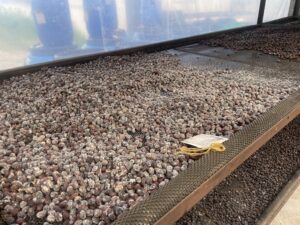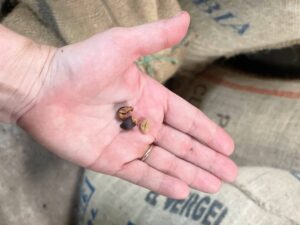What is coffee cupping, you ask? And how can you, as an at-home barista, use it? Let us tell you!
Definition
Cupping refers to the standard method used in the coffee industry to taste and evaluate beans. It’s a stripped-down brewing method that requires as little equipment as possible making it accessible at every level of the farm-to-cup process, and with as few variables as possible. From some producers to green bean buyers to roasters to baristas, cupping is used as a form of assessment, quality control, and palate development.
Equipment
Required equipment includes a scale, a grinder, a cupping bowl, and a cupping spoon. A cupping bowl is either ceramic or tempered glass and should hold approximately 200 mL of water, while a cupping spoon is wider and heavier than a normal spoon, and generally made of nicer materials so as not to impart flavours or modify the mouthfeel.
Process
At the end of this article is an exact process, but here is the general rundown of how a cupping works. First, a small amount of beans is weighed out, ground at a medium coarseness, and placed in a cupping bowl. The grounds are then steeped in hot water. As it steeps, some of the grounds float to the top of the bowl, forming what is known as the “crust.” At around 4 minutes, the crust is broken with a cupping spoon, and it’s at this stage that the coffee’s fragrance is usually evaluated. Then the crust is scooped out and the remaining coffee is allowed to cool slightly before tasting. To taste, a small amount of coffee is scooped out with a cupping spoon and then slurped (the louder the better!) by the taster. Slurping ensures the coffee is aerated and covers as much of the taster’s palate as possible in order to taste all its nuances. As cuppings are most frequently used to taste multiple coffees alongside each other, ensure to dip the spoon in a rinse cup between each tasting. (If you’re interested in official technicalities, here is the protocol put forward by the SCA.)

Why and when do cuppings occur?
When cupping, it depends why you’re cupping to determine which elements you want to pay attention to. Many coffee professionals, including Q-graders, utilize the Specialty Coffee Association’s (SCA) scoring sheet to assign cupping scores and issue scoring certificates—but that’s is a whole OTHER blog post. Like we mentioned earlier, cupping is used at every stage of the coffee production chain for a variety of reasons. Coffee producers sometimes use cupping as a form of quality control to check for defects in their crops. We will note, however, that this is a rare occurrence, and often producers don’t actually know what their crops taste like. Green bean buyers will cup when looking for lots to purchase. They are looking for qualities they think roasters and consumers will be interested in, while also ensuring there are no defects. Even though green buyers are tasting roasted beans, they are attempting to look past the roast and taste qualities of the green bean. Then, at the roasting stage, roasters will cup to assess their different roast profiles and make adjustments. Baristas will cup coffees to develop their palates, and even compete in tasting competitions!
And finally: For us at-home baristas, cupping is a good way to taste two or three coffees side-by-side to develop our palates. We recommend starting by noticing differences in the coffees—how are they different? How would you describe it? Not only does this help develop your palate, it’s also a great way to expand your coffee vocabulary. When noticing the taste, what flavour notes are present? Do they last all the way from the first taste to aftertaste, or do they evolve? When noticing the mouthfeel, is it light and tea-like, or robust and rich? Is the coffee balanced, or are some elements more noticeable than others?
How to Taste
Here are some basic elements you can focus on to get a solid, well-rounded sense of a coffee. We’ve drawn from the SCA’s scoring sheet, but since we’re focusing on tasting practice and personal preference and not on scoring, this is a modified list of qualities to focus on.
Fragrance: What the dry coffee grounds smell like.
Aroma: What the coffee smells like when the crust is broken.
Flavour: Tasting notes. (You can find the SCA’s tasting wheel here.)
Aftertaste: Length of flavour once swallowed and the pleasantness of the aftertaste.
Acidity: While yes, acidity is inherent to coffee and affected by origin, different processing methods and roast profiles will alter the intensity of a coffee’s acidity. A more intense acidity will often manifest in descriptions such as “bright,” “lively,” and citrusy tasting notes, while lower acidity coffees might be described as “nutty” or “mellow.”
Body: Refers to the mouthfeel, or the physical qualities, of a coffee. Here, you would be evaluating the viscosity, density, and generally how it feels on your palate. A lighter body might have descriptions like “tea-like” or “delicate,” and fuller bodied coffees might be described as “rich,” “velvety,” or “syrupy.”
Balance: Between acidity, aroma, flavour, and body. Is one more prominent than the other? Are they all equally present?
Sweetness: Sweetness, like acidity, can also be affected by origin, varietal, processing, and roasting. This often manifests in terms of fruit and chocolate tasting notes.
Overall: This is your overall impression and biased opinion; as we always preach, personal preference trumps everything. What matters is that you like it!
How does Doorstep Barista use cupping?
Here at Doorstep Barista, we use cupping to match coffees to our six different taste profiles. When we partner with roasters, we request samples to cup. While cupping, we make sure to have a “control” coffee, which is a coffee that we taste alongside every sample from every roaster to ensure as much consistency as possible in our matching of coffees to taste profiles. Our control ranks at a 4 on the spectrum of our taste profiles. We take extreme care to do this with each sample to make sure you only get coffee you love!

As promised, here is an exact cupping process to follow so you can try it at home!
Equipment:
- A scale
- Cupping spoon or soup spoon
- Cupping bowl or small bowl made of ceramic or tempered glass; one for each coffee you are cupping, and one with hot water for rinsing in between tastes.
- Hot water
- Coffee(s)!!
Instructions
- Weigh out 11 g of coffee.
- Grind at a medium coarseness and place in cupping bowl.
- Place cupping bowl on scale and pour 200 g of hot water over the grounds, ensuring to evenly wet the coffee. Start a timer for 4 minutes.
- Once 4 minutes is up, break the crust with the back of cupping spoon. Then scoop the crust out and discard. Rinse cupping spoon.
- Allow coffee to cool slightly before scooping a small amount out and slurping to taste.
- Note what you taste and your personal preferences!







